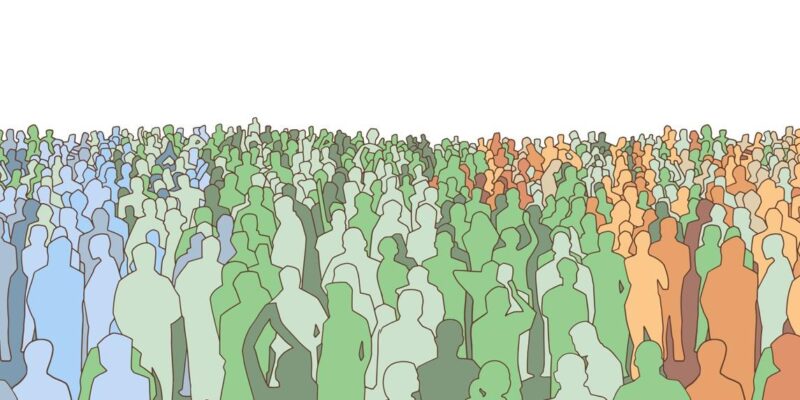
When the Soviet Union began its collapse in 1989, the world witnessed decentralization and secession on a broad scale.
Over the next several years, puppet regimes and states that were independent in name only broke away from Soviet domination and formed sovereign states. Some states which had completely ceased to exist—such as the Baltic states—declared independence and became states in their own right. In its heyday, the Soviet Union had been three times the size of the United States, and was controlled by a regime with nearly untrammeled power consolidated in a centralized state. In its place rose a number of new regimes that were smaller in size and smaller in population.
In total, secession and decentralization in this era brought about more than a dozen newly independent states.1
Political decisions that had once been made unilaterally in Moscow now were being made in numerous places; places like Riga in Lithuania, Kiev in Ukraine, and Yerevan in Armenia.
This period served as an important reminder that human history is not, in fact, just a story of ever-increasing state power and centralization.
Since then, however, the world has seen few successful secession movements. A handful of new countries have come into being over the past twenty years, such as East Timor and South Sudan. But in spite of many efforts by separatists worldwide, there have been few changes to the lines on the maps.
This has certainly been the case in Europe and the Americas, where from Quebec to Scotland to Catalonia to Venice demands for independence have been met with trepidation and sometimes outright threats of violence from central governments.2
Benefits of Bigness: More Sources of Wealth for Costly State Institutions
State opposition to any movement toward dismemberment is partly due to the fact that state organizations—that is, the people who control them—are motivated to cling to the benefits conferred by bigness.
Much of this stems from the nature of states themselves. The ideology underpinning the modern sovereign state—also known as the “Westphalian state”—is founded largely on the idea that states ought to secure and protect a monopoly on the means of coercion within a specific territory. This process of statebuilding often involved the physical invasion of independent regions and territories within a potential state’s territory, and the neutralization of any military forces answerable to local nobles or municipal governments. As a state’s rulers sought to consolidate power, they pursued new ways to limit the power of local power centers such as cities, guilds, religious organizations and the local nobility. When successful, this strategy enabled state rulers to control resources directly rather than indirectly through local institutions. Ideally, state rulers built up large state bureaucracies answerable to—and funded directly by—the central state. More specifically, states must, as described by political scientist Charles Tilly,
Produce distinct organizations that control the chief concentrated means of coercion within well-defined territories, and exercise priority in some respects over all other organizations operating within those territories. Efforts to subordinate neighbors and fight off more distant rivals create state structures in the form not only of armies but also of civilian staff that gather the means to sustain armies and that organize the ruler’s day-to-day control over the rest of the civilian population.3
According to Tilly, these “distinct organizations” clearly include armies, but they also include organizations such as police, a bureaucracy for collecting taxes, and a prison system. Most important are the institutions that ensure physical control over the state’s potential enemies both foreign and domestic. As Murray Rothbard has noted:
What the State fears above all, of course, is any fundamental threat to its own power and its own existence. The death of a State can come about in two major ways: (a) through conquest by another State, or (b) through revolutionary overthrow by its own subjects—in short, by war or revolution. War and revolution, as the two basic threats, invariably arouse in the State rulers their maximum efforts and maximum propaganda among the people.4
The occasional need for “maximum propaganda” also highlights a state’s need for “soft power.” This generally includes educational institutions and other organizations that employ intellectuals to help convince the population that a state is both beneficial and necessary.
The supposed benefits of state power to the general public can also be displayed through a welfare state. This aspect of extending state power did not develop much sophistication until the nineteenth century when the German Otto von Bismarck “established compulsory accident, sickness, and old-age insurance for workers.”5 That is, he took the first steps toward a permanent and bureaucratic “safety net” for the population within Bismarck’s newly crafted German empire. But, as Robert Higgs recognized, “Bismarck was no altruist. He intended his social programs to divert workingmen from revolutionary socialism and to purchase their loyalty to the Kaiser’s regime; to a large extent he seems to have achieved his objectives.”6
Welfare states need not be established out of cynical motives, of course, but their end effect is the same. As Martin van Creveld observes, the welfare state was essential in “tightening the state’s grip on the economy” which had the additional benefit of “eradicating or at least greatly weakening lesser institutions” which had provided charity and economic benefits in earlier times.7
Naturally, this is all very costly to the state, so states will tend to seek direct access to reliable sources of wealth and geopolitical power. This can often be augmented through growth in either physical size or population—or both.
By this way of thinking, the most safe and secure states are those that can best physically control the means of military defense, punish the disobedient, dole out economic benefits, and provide funding to teachers and intellectuals.
For example, greater size means a larger frontier that can act as a physical buffer between the state’s enemies and the state’s economic core. Physical size is also helpful in terms of pursuing self-sufficiency in both energy production and agriculture. More land means greater potential for resource extraction and acreage devoted to food production. The wages and capital accumulation that arises from these activities can also be taxed, expropriated, or otherwise controlled to benefit the state itself.
In terms of population size, state control over larger populations means more human workers to tax. Larger populations also provide personnel for military uses.
Naturally, state organizations are not inclined to abandon these advantages lightly, even if a sizable portion of the population begins to move in the direction of secession.
Why States Sometimes Get Smaller
Sometimes, though, states are forced to contract in size and scope. This usually happens when the cost of maintaining the status quo becomes higher than the cost of allowing a region to gain autonomy.
Historically, the cost to the state of maintaining unity is raised through military means. Once a region in rebellion becomes sufficiently costly, it is abandoned by the outgoing central government.8 Examples of this tactic being successfully employed include the cases of the United States, the Republic of Ireland, and some of the successor states of Yugoslavia.9
But secession and decentralization have also often been achieved through bloodless or near bloodless means. This was the case in Iceland in 1944 and throughout most of the post-Iron Curtain states.
Bloodless secession movements, however, tend to enjoy the most success when the parent state is weakened by larger events beyond the secession movement itself. Iceland, for example, seceded in 1944 when World War II ensured that Denmark was in no position to object.10 The post-Soviet states seceded when the Soviet state had been rendered impotent by decades of economic decline and (in 1991) a failed coup.11 Nor is it a coincidence that India gained independence from the United Kingdom in the years immediately following World War II. It is likely the UK could have held on to India through military means indefinitely, but this would have come at a very high cost to the British economy and standard of living.
It is possible to envision largely “amicable” separations. The model for this is the separation of Canada, Australia, and New Zealand from the United Kingdom. But even in these cases, British control over these Commonwealth states’ foreign policy was not totally abandoned until after World War II, when the British state had been weakened by depression and war. Moreover, the British state assumed that these newly independent states would remain highly reliable geopolitical and economic allies indefinitely. Thus, the geopolitical cost of separation was perceived to be low.
Mega-States Are the Ideal State (From the State’s Perspective)
In cases where the seceding state is perceived to have different cultural, economic, or geopolitical interests—which is true of the overwhelming majority of cases—the parent state is, all else being equal, likely to meet demands for secession with much hostility.
Although liberal ideology has diminished the perception among much of the world’s population that bigger is better, most government agents—who are by nature decidedly illiberal—see things differently. For them, the ideal state is most certainly a large state.
Those who delight in the generous application of state violence have noticed that it is not a coincidence that the world’s most powerful states—e.g., the US, Russia, China—are often those that control large populations, large economic centers, and large geographic areas with sizable frontiers. The combination of these three factors in various configurations ensures that existential threats to the regime are few and far between. Russia’s relatively small economy—only a fraction of the size of Germany’s economy—is mitigated by its enormous geographical frontiers. Its economy is nonetheless large enough to maintain a nuclear arsenal. China’s per capita wealth is quite small, but Chinese territory, its limited nuclear arsenal, and the sheer size of its overall economy ensure a high degree of protection from foreign attack. The US’s enormous economy and its huge ocean frontiers render it essentially immune to all existential threats other than large-scale nuclear war.
Large states such as these are limited only by the military capabilities of other states, and by the threat of domestic unrest and resistance.
Totalitarian States Require Bigness
This relationship between bigness and state power has been illustrated in the fact that totalitarian states are virtually always large states.
In her book The Origins of Totalitarianism, Hannah Arendt examines a number of nontotalitarian dictatorships that sprang up in Europe before the Second World War. These included (among others) the Baltic states, Hungary, Portugal, and Romania. In many of these cases, Arendt contends the regimes attempted to turn themselves into totalitarian regimes, but failed. This was largely due to their lack of size:
Although [totalitarian ideology] had served well enough to organize the masses until the movement seized power, the absolute size of the country then forced the would-be totalitarian ruler of masses into the more familiar patterns of class or party dictatorship. The truth is that these countries simply did not control enough human material to allow for total domination and its inherent great losses in population. Without much hope for the conquest of more heavily populated territories, the tyrants in these small countries were forced into a certain old-fashioned moderation lest they lose whatever people they had to rule. This is also why Nazism, up to the outbreak of the war and its expansion over Europe, lagged so far behind its Russian counterpart in consistency and ruthlessness; even the German people were not numerous enough to allow for the full development of this newest form of government. Only if Germany had won the war would she have known a fully developed totalitarian rulership.12
Arendt was not an economist, but had she been one, she might have noted that the necessity of size is so central to totalitarian regimes because they are so economically inefficient. Contrary to promises of machine-like efficiency made by advocates of ever more powerful states, totalitarian states are absurdly wasteful both in terms of capital and human life. The same is true—to varying extents—for all regimes. But as the most centrally-planned ones—whether totalitarian or not—quickly become economic basket cases, large size is necessary.13 A smaller state would quickly exhaust its capital and its population, and the regime would collapse. Size can provide the appearance of sustainability for longer.
Cultural factors cannot be ignored, however. Arendt concedes this process of collapse can be drawn out longer in societies that are more ideologically tolerant of it:
Conversely, the chances for totalitarian rule are frighteningly good in the lands of traditional Oriental despotism, in India and China…14
That region’s relative tolerance for despotism is enabled by local ideologies that foster a “feeling of superfluousness,” which according to Arendt “has been prevalent for centuries in the contempt for the value of human life.”15
None of this means the world is now absent of small states that attempt to maximize the regime’s power. Some small states, such as North Korea, have maintained an economically isolationist and totalitarian stance—fueled both by internal paranoia and by real perennial threats issued by the regime’s enemies. For the most part, however, the spread of markets (and promarket ideology) has raised the opportunity cost of militaristic expansion from the state’s perspective. If offered the chance to expand at low cost, though, virtually all regimes would take the opportunity in a heartbeat. And this is why we will likely continue to see regimes enthusiastically resist secession within their own borders. States don’t have many opportunities to expand their territories and populations. So they’re not about to sign off on secession lightly. Nevertheless, new economic realities, wars, and demographic shifts may certainly affect the equation in coming years. And then we may again see a redrawing of maps of a sort not seen since the end of the Cold War.
[This article is chapter 3 of Breaking Away: The Case for Secession, Radical Decentralization, and Smaller Polities. Now available at Amazon and in the Mises Store.]
1. This was part of an even larger global trend from 1950 to 2000. During this period, the total number of independent nations almost doubled to 191. Many of these new states were formed out of Europe-based empires that slowly collapsed during the 1950s and 1960s.
2. Nick Squires, “Venice prepares for referendum on secession from Italy,” The Telegraph. March 14, 2014, https://www.telegraph.co.uk/news/worldnews/europe/ italy/10698299/Venice-prepares-for-referendum-on-secession-from-Italy.html.
3. Charles Tilly, Coercion, Capital, and European States: AD 990–1992 (Malden, Mass.: Blackwell Publishers, 1992), p. 19.
4. Murray N. Rothbard, “Anatomy of the State,” mises.org, 2009, https://mises.org/library/anatomy-state.
5. Robert Higgs, “The Welfare State and the Promise of Protection,” Mises Daily, August 24, 2009, https://mises.org/library/welfare-state-and-promise-protection.
6. Ibid.
7. Martin Van Creveld, The Rise and Decline of the State (Cambridge, U.K.: Cambridge University Press, 1999), pp. 354–56.
8. Jörg Guido Hülsmann, “Secession and the Production of Defense,” in The Myth of National Defense, ed. Hans-Hermann Hoppe (Auburn, Ala.: Mises Institute, 2003), p. 380.
9. The Republic of Ireland employed violence to obtain independence, although it is unlikely that Ireland would have obtained independence when it did had the British state not been weakened by the First World War.
10. In a 1918 plebiscite, Iceland’s voters approved independence for the country in a personal union with Denmark under the Danish king. (The king would remain the head of state. Iceland became a republic after another plebiscite in 1944.)
11. Specifically, the “August Coup” of 1991 during which Soviet hardliners attempted to seize control of the regime from Mikhail Gorbachev.
12. Hannah Arendt, The Origins of Totalitarianism (New York: Harcourt, 1976), p. 310.
13. Centrally-planned economies fall victim to what Ludwig von Mises called the economic calculation problem, and quickly become wasteful and inefficient in proportion to the degree to which the private-sector economy is socialized. See Ludwig von Mises, “Economic Calculation in the Socialist Commonwealth” (Auburn, Ala.: Mises Institute, 2012).
14. Arendt, The Origins of Totalitarianism, p. 311.
15. Ibid.








